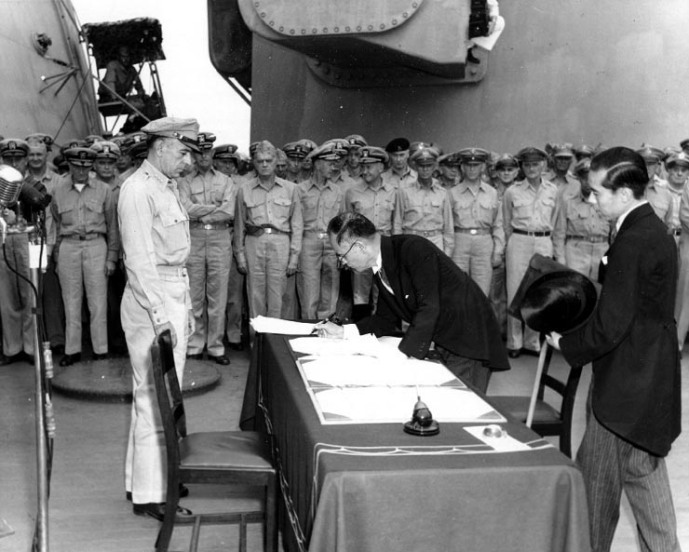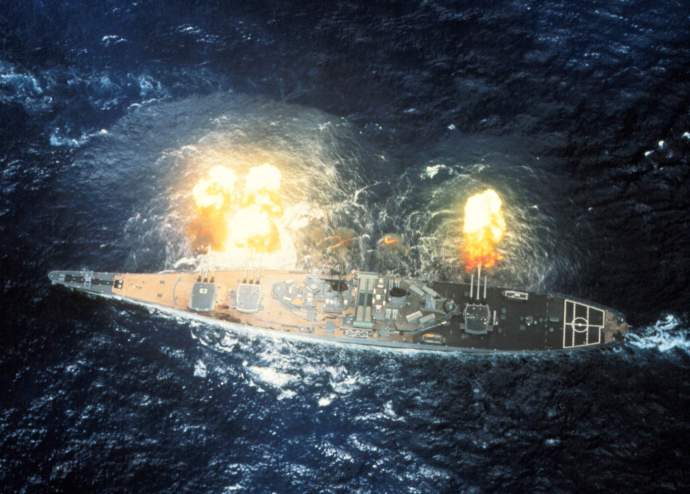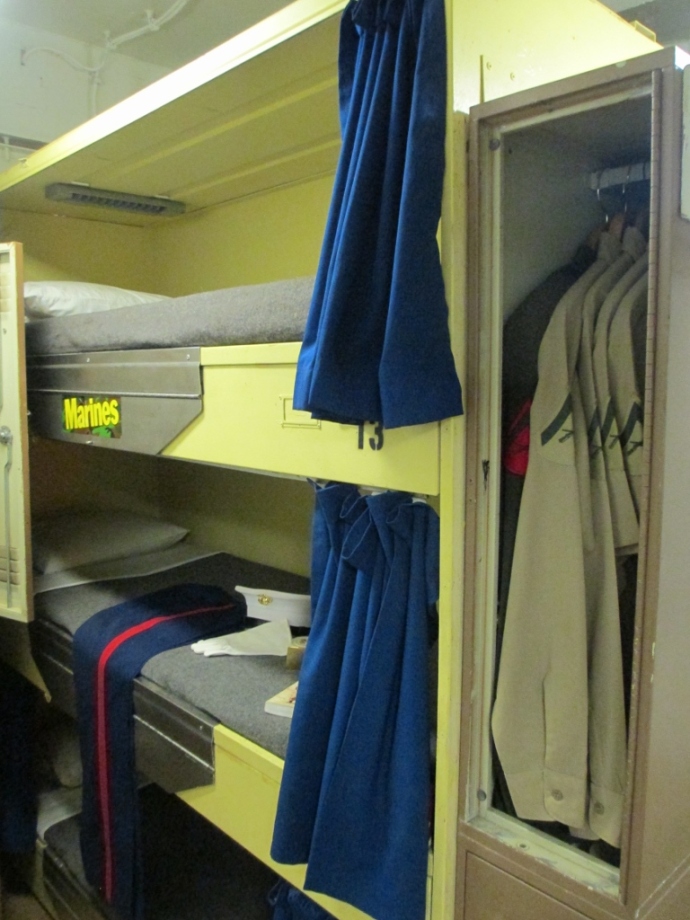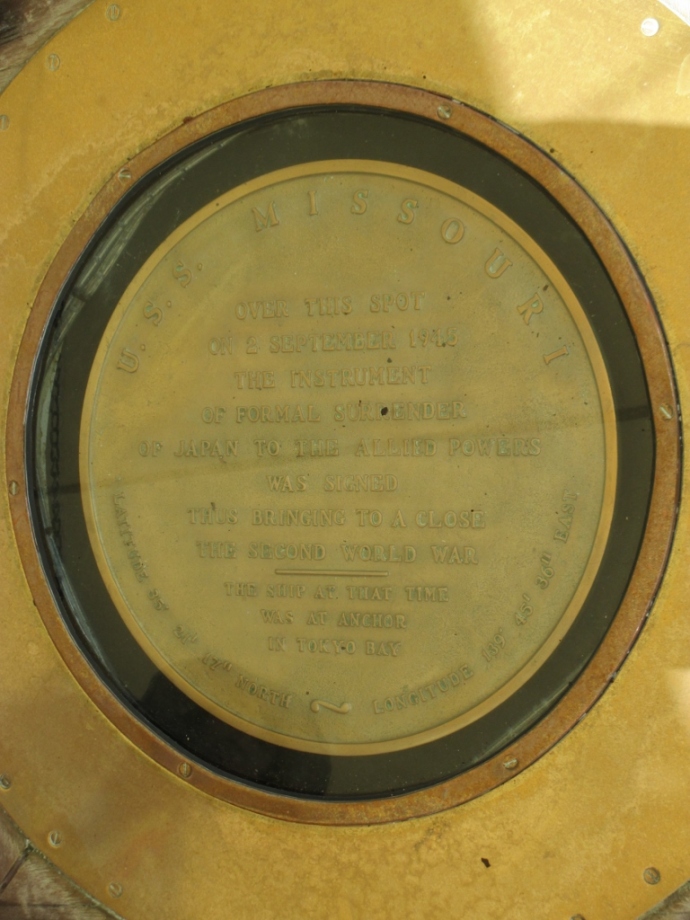The USS Missouri (BB-63) is an Iowa Class Battleship launched January 29th, 1944 and commissioned on June 11th, 1944. She served in the US Navy until 1955 when she became part of the ready reserve “Mothball Fleet” but was recommissioned in 1986 and went back into service until 1992. At 270.4 metres (887.3 feet) in length with a displacement of 45,000 tonnes she is a big and powerful battleship most deserving of the nickname “Mighty Mo“. When in service she was fast too with a top speed of 33 knots!

WORLD WAR TWO
Upon fit out in World War Two USS Missouri had a crew of 2,700 and was heavily armed with three main gun turrets each fitted with three 16 inch guns that provided enormous firepower (they could reportedly blow a hole in the ground the size of a football field!) along with a further twenty 5 inch guns for closer action. For air defence the battleship was fitted with eighty 40 mm and forty-nine 20 mm anti-aircraft guns.

During 1945 the USS Missouri served in the Pacific theatre as a fleet flagship providing protection to aircraft carrier groups and conducting bombardments of Japanese positions during the invasion of the Japanese island of Iwo Jima in February 1945 and the bombardment of Okinawa in March 1945. Her heavy weaponry provided significant fire support to the troops involved in the battles.

On April 11th, 1945 Missouri was struck by a very low flying Japanese Kamikaze aircraft off the coast of Okinawa. This attack caused a fire in a rear gun turret, but was quickly controlled with only minor damage to the battleship and no crew casualties. The pilot’s body was recovered following the attack and he was given a formal burial at sea the next day. The battleship continued to participate in attacks on Okinawa until early June 1945.

In mid July 1945 she participated in the bombardment of the Japanese home islands destroying targets on Hokkaido and Honshū (respectively the second largest and largest Japanese islands). During this time the battleship also protected the aircraft carriers that were launching raids against Japan (there really was no Japanese fleet to speak of by this stage of the war though). Strikes continued on Japan until the second atomic bomb was dropped on August 9th, 1945 at Nagasaki (the first was dropped on Hiroshima on August 6th) which lead to the ultimate surrender of Japan. This is where the USS Missouri played a major part in history.

On the morning of September 2nd, 1945 Allied Commanders boarded the USS Missouri docked in Tokyo Bay to participate in the signing of the formal surrender by Japan. The surrender ceremony was conducted right there on the deck of the battleship. These men included US Navy Fleet Admiral Chester Nimitz, US Army General Douglas MacArthur, British Admiral of the Fleet Sir Bruce Fraser, Australian General Sir Thomas Blamey, Canadian Colonel Lawrence Moore Cosgrave, Chinese General Hsu Yung-Ch’ang, French General Philippe Leclerc de Hautecloque, New Zealand Air Vice Marshall Leonard Isitt and Soviet Lieutenant-General Kusma Nikolaevich Derevyanko.

As Supreme Allied Commander in the Pacific General Douglas MacArthur opened the surrender ceremony with the following statement:
“It is my earnest hope, indeed the hope of all mankind, that from this solemn occasion a better world shall emerge out of the blood and carnage of the past, a world founded upon faith and understanding, a world dedicated to the dignity of man and the fulfillment of his most cherished wish for freedom, tolerance, and justice.”‘

The Japanese delegation was led by Foreign Minister Mamoru Shigemitsu who represented the Japanese Government and General Umezu who represented the Japanese military. Their signatures on the Japanese Instrument of Surrender formally ended World War Two.





The record of the USS Missouri was exemplary during World War Two and she was awarded 3 Battle Stars during the conflict (awarded for meritorious participation in battle or for sustaining damage during battle). The surrender ceremony was held on the battleship as it was US territory and the ultimate display of the power of the US Navy. What better place for a former foe to be humbled into surrender?
POST WAR
Following World War Two the US Navy was significantly downsized and all the battleships were decommissioned except USS Missouri which President Harry S. Truman wanted to remain in the fleet. The battleship predominately served in the Atlantic fleet from 1946-1950 conducting training voyages, exercises and a show of force when needed be to reinforce the US commitment to defending nations against Soviet influence whenever required.

KOREAN WAR
Just 5 years after the end of World War Two the Korean War (1950-1953) broke out. It was the height of the Cold War and it was a battle of the Communist east versus the United Nations made up predominately of US forces. In September 1950 the USS Missouri once again went into action as a flag-ship to provide massive fire support for the troops on the ground fighting the North Koreans and then from October 1950 the Chinese army who had joined the fight to help their Communist allies.

The battleship stayed on station off various points around the coast of Korea conducting shore bombardment and aircraft carrier escort until March 19th, 1951 when she returned to the base and later resumed other duties. In October 1952 she returned to Korea for a second tour of duty and remained on station there until April 6th, 1953. During the Korean War the USS Missouri was awarded 5 Battle Stars for meritorious participation in battle.
Following the Korean War the USS Missouri returned to base for refitting and then participated in various training missions. After almost 11 years of valuable service she was decommissioned on February 26th, 1955 and joined the ready reserve “Mothball Fleet” at the Puget Sound Navy Yard in Bremerton, Washington. For the next few decades she became a tourist attraction up there with people coming to see where the Japanese had surrendered in World War Two (a bronze plaque was placed on the deck to commemorate the spot the surrender documents were signed).
A RETURN TO SERVICE
During the Cold War of the 1980’s as part of the 600 ship fleet plan to rebuild the US Navy after the downsizing that occurred following the Vietnam war it was decided to put the Iowa Class Battleships back into service. This included the USS Iowa (BB-61 was originally decommissioned in 1958), USS New Jersey (BB-62 was decommissioned in 1969 following service in the Vietnam War), USS Missouri (BB-63 decommissioned 1955) and USS Wisconsin (BB-64 decommissioned in 1958). The refit of the USS Missouri commenced in 1984 and she was recommissioned and went back into service in 1986 following an extensive modernization of command and weapons systems.

The weapons systems received a major upgrade including the fitting of Tomahawk cruise missile launchers (32 missiles were carried) and Harpoon anti-shipping missile launchers (16 missiles). The battleship retained the big guns but reduced the 5 inch guns to twelve and replaced the obsolete anti-aircraft guns with four radar guided 20mm Phalanx Close In Weapons Systems (CIWS) for use against incoming missiles.





During the refit the USS Missouri was also fitted with extensive electronic counter measures and decoy systems to survive in modern sea warfare. With modern innovation and improved weapons the crew during this period was reduced from 2,700 (WW2) to 1,851.

Once ready for duty an around the world voyage was in order. USS Missouri set out from Long Beach, California to Hawaii, Australia, across the Indian Ocean, through the Suez Canal to Turkey, Italy, Spain, Portugal and then through the Panama Canal to return home. This was the first such voyage by a US Navy battleship since President Theodore Roosevelt ordered “The Great White Fleet” of 16 battleships that were all painted white to circumnavigate the world from 1907-1909 as a show of the growing might of the US military (this fleet included BB-11 the second ship in the US Navy to be called USS Missouri).

In 1987 the battleship headed to the Persian Gulf to participate in Operation Earnest Will (July 24th, 1987 to September 26th,1988) which was a mission to escort oil tanker convoys to protect them from Iranian aggression. It was a tense time in the region and the battleship was there to protect from Iranian high-speed attack boats and shore based Silkworm anti-shipping missiles (20mm grenade launchers and 25mm chain guns were fitted to the USS Missouri to counter such threats).
In July 1988 the battleship headed to Hawaii for the Rim of the Pacific (RIMPAC) military exercises involving navy ships from Australia, Canada, Japan and the US. This was a great display of the formidable firepower USS Missouri could unleash


In 1989 whilst back in her home port of Long Beach, USS Missouri was bizarrely the setting for the Cher music video for If I Could Turn Back Time where she famously wore a very skimpy outfit and straddled one of the big guns! Crew members also featured in the video.
THE GULF WAR
By January 1991 USS Missouri was back to serious business and found herself in the Persian Gulf once again. This time it was for Operation Desert Storm. In August 1990 Iraq had invaded Kuwait and the US and Coalition forces had assembled to push them out and defeat Saddam Hussein’s forces. During that time the Iraqi navy and air force stood no chance of attacking the ship but they did manage to fire 2 Silkworm missiles from a shore base at the USS Missouri. The first missed and the second was shot down by a British escort ship.

Operation Desert Storm ended on February 28th,1991 and the USS Missouri returned home on March 21st, 1991. During the Gulf War the battleship was awarded 3 Battle Stars for meritorious participation in battle which included fire support missions, clearing naval mines and the launch of Tomahawk cruise missiles against Iraqi targets.

RETIREMENT
Following the Gulf War and the collapse of the Soviet Union in 1991, military budgets were cut and the expense of maintaining old battleships as part of US Fleet was no longer feasible. On March 31st, 1992 USS Missouri was decommissioned at Long Beach, California. After sitting idle in the “Mothball Fleet” for a few years she was towed to Hawaii from the mainland in 1998.


The battleship had played a significant role in US Navy and world history, earning 11 Battle Stars in the process and today she rightfully resides in a sacred place to the US Navy. She is a key part of the memorials and museums at Pearl Harbour in Hawaii and is berthed along the famous battleship row on Ford Island right next to the USS Arizona memorial.






Exploring the battleship and walking those hallowed decks is a great experience and a must do if you are ever in Hawaii. Standing under the mighty 16″ guns is a bit overwhelming and exploring the somewhat cramped quarters and the bridge of the battleship give you an appreciation of the inner workings and daily life aboard USS Missouri. It is well worth taking the time to explore the entire battleship.








Stand where the Japanese Kamikaze plane hit and where the Japanese surrender documents were signed. Soak up the history and remember those that served.





The Battleship was once the might of a navy but today aircraft carriers lead the way. These behemoth battleships are a relic of a bygone era but they are still fascinating to see to take in their sheer size and firepower. I have now been to see 3 of the 4 Iowa Class battleships having also visited both the USS New Jersey in Cambden, New Jersey and USS Wisconsin in Norfolk, Virginia in 2013.


That just leaves the USS Iowa out in Los Angeles, California which I hope to see some time in the near future (I was in LA in 2013 too, should have gone!). The history around USS Missouri is hard to beat though, so if you can only see one then I would recommend you walk those hallowed decks some day.
UPDATE OCTOBER 2014
I finally got to see USS Iowa (BB-61) in San Pedro, California! It was great to close out seeing the “Big 4” US Navy battleships of World War Two and the Cold War.

Nice post and something new and interesting from history…Bye. Kamila
Thanks. This ship had such a significant history in the US Navy
Impressive series of pictures!
Its an impressive ship! I recently saw USS Iowa BB-61 too (a post will follow)
where is original round plaque from sept 2 1945. and is there any copies out there floating around
My understanding is that the original was cast about one month after the surrender. It remained on the USS Missouri but was getting pretty worn out so was replaced by an exact duplicate in 1989. The original I believe is in the possession of the US Navy Museum in Washington DC but it was not on display when I visited there in 2013. I do not know of any other duplicates
I think they lost or original plaque was given to someone by us naval base in california in. 1953 other wise such an inportant plaque would be on display i seen original plaque i think was original was still in teek would luckly someone purchased it it was on its way to be sold as junk metal it should be in a museum so the whole world can see its one of our inportant peices of history and would think priceless wonder how one would go about authenticateing it and should only be sold or auctioned to museum
Hi Fred – this LA Times article mentioned it went to the Navy Museum in DC http://articles.latimes.com/1989-08-24/news/hl-1206_1_bronze-plaque
I have emailed the museum for more info. Will let you know